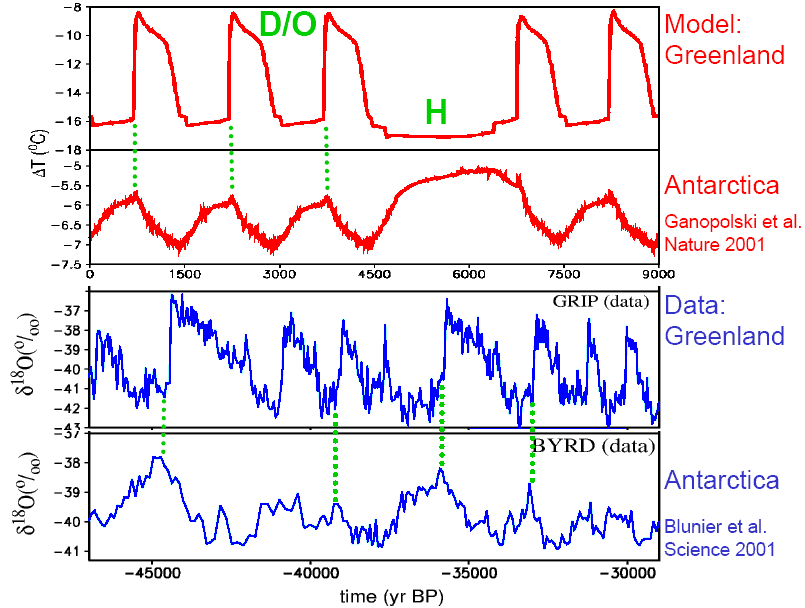Typically, when Greenland gets warmer and melts a bit, Antarctica gets even colder, and of course, vice-versa.

Figure: The top two panels show idealised model DO [“Dansgaard-Oeschger”] events on an arbitrary time axis (in years), highlighting the phase relationship between Greenland and Antarctic temperatures: when a DO event hits Greenland, Antarctica switches from warming trend to cooling trend. The bottom panels show the “real thing”, the noisy data from ice cores. Note the expanded scale for Antarctica in both cases. Time here runs from left to right – normal for regular folks, but somewhat unusual for the ice core experts (my apologies to these).
...irrespective of the details: the new data from Antarctica clearly point to ocean heat transport changes as the explanation for the abrupt climate changes found in Greenland. We are thus not talking about changes primarily in global mean temperature (these are small in the model results shown above). We are talking about what I call a climate change of the second kind: a change in how heat is moved around the climate system...
There are very few possibilities to change the global mean temperature, a climate change of the first kind: you have to change the global heat budget, i.e. either the incoming solar radiation, the portion that is reflected (the Earth’s albedo), or the outgoing long-wave radiation (through the greenhouse effect). Temporarily, you can also store heat in the ocean or release it, but the scope for changes in global mean temperature through this mechanism is quite limited.
Changes of the second kind are due to changes in heat transport in the atmosphere or ocean, and these can occur very fast and cause large regional change. Think of your tub: if you want 10 cm higher water level at one end, you can achieve this by turning on the tap – but you can get there much faster by pushing some water over there with your hand, albeit temporarily and at the expense of the water level at the other end. That kind of “see-saw” (but with heat, not water) apparently happens during DO events, as the new data confirm.
The two kinds of climate change are sometimes confounded by non-experts – e.g., when it is claimed that DO events represent a much larger and more rapid climate change than anthropogenic global warming. This forgets that our best understanding of DO events suggests they are changes of the second kind. The same error is made by those who claim that the 1470-year cycle associated with the DO events could lead to an “unstoppable global warming”. A global warming of 3 or 5 ºC within a century, as we are likely causing in this century unless we change our ways, has so far not been documented in climate history...
What makes what's happening now different is that both poles are melting.

No comments:
Post a Comment